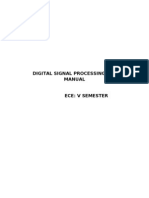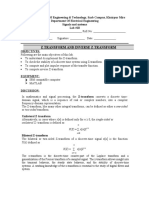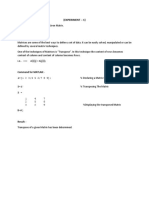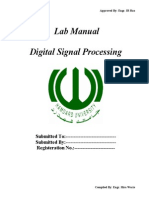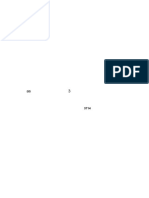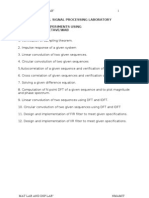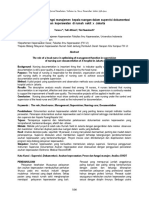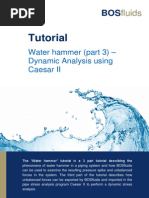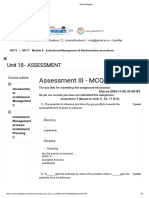Rakshk ASP Lab
Rakshk ASP Lab
Uploaded by
Rakesh AseryCopyright:
Available Formats
Rakshk ASP Lab
Rakshk ASP Lab
Uploaded by
Rakesh AseryOriginal Description:
Copyright
Available Formats
Share this document
Did you find this document useful?
Is this content inappropriate?
Copyright:
Available Formats
Rakshk ASP Lab
Rakshk ASP Lab
Uploaded by
Rakesh AseryCopyright:
Available Formats
EC-553 Advanced Signal Processing Laboratory 2014
Experiment No:-[1]
EXPERIMENT: - Generate basic signals using matlab.
SOFTWARE REQUIRED: - Matlab 7.12.0.
THEORY:1) The sine wave or sinusoid is a mathematical curve that describes a smooth repetitive oscillation.
L=sin(2*pi*f*t)
2) A square wave is a non-sinusoidal periodic waveform (which can be represented as an infinite
summation of sinusoidal waves), in which the amplitude alternates at a steady frequency between
fixed minimum and maximum values, with the same duration at minimum and maximum.
3) In mathematics, a function on the real numbers is called a step function (or staircase function) if
it can be written as a finite linear combination of indicator functions of intervals. Informally
speaking, a step function is a piecewise constant function having only finitely many pieces.
4) The ramp function is a unary real function, easily computable as the mean of the independent
variable and its absolute value.
5) In mathematics, the Dirac delta function, or function, is a generalized function, or distribution,
on the real number line that is zero everywhere except at zero, with an integral of one over the entire
real line.
6) The sawtooth wave (or saw wave) is a kind of non-sinusoidal waveform. It is so named based on
its resemblance to the teeth of a saw.
MATLAB CODE:clear all;
close all;
clc;
t1=-2:0.01:2;
f=1;
%SINE FUNCTION
L=sin(2*pi*f*t1);
subplot(3,2,1);
plot(t1,L);
xlabel('Time');
ylabel('Amplitude');
title('Sine Funcion');
%STEP FUNCTION
1
Department of Elect. and Comm. Engg. , Dr. B R Ambedkar National Institute of Technology, Jalandhar
EC-553 Advanced Signal Processing Laboratory 2014
t2=-4:0.5:4;
M=[0 0 0 0 0 0 0 0 1 1 1 1 1 1 1 1 1];
subplot(3,2,2);
stem(t2,M);
xlabel('Time');
ylabel('Amplitude');
title('Step Function');
%RAMP FUNCTION
t3=0:0.01:5;
a=4;
N=a*t3;
subplot(3,2,3);
plot(t3,N);
title('Ramp Funcion');
xlabel('Time');
ylabel('Amplitude');
%SQUARE FUNCTION
for t= 1:1:401
if L(t)>0
O(t)=1;
else
O(t)=0;
end
end
subplot(3,2,4);
plot(O);
xlabel('Time');
ylabel('Amplitude');
title('Square Function');
%IMPULSE FUNCTION
t4=-4:1:4;
P=[0 0 0 0 1 0 0 0 0];
subplot(3,2,5)
stem(t4,P);
xlabel('Time');
ylabel('Amplitude');
title('Impulse Function');
%SAWTOOTH FUNCTION
x=0:1:5;
for i=1:length(x)
y(i)=x(i);
end
Q=repmat(y,1,3);
subplot(3,2,6)
stem(Q);
xlabel('Time');
ylabel('Amplitude');
title('Sawtooth Function');
RESULTS: - We have successfully generated basic signals using matlab.
Department of Elect. and Comm. Engg. , Dr. B R Ambedkar National Institute of Technology, Jalandhar
EC-553 Advanced Signal Processing Laboratory 2014
CONCLUSION: - The entire basic function performed successfully using MATLAB. Basic of
signals are revised and also the command sine, repmat familiarized.
Department of Elect. and Comm. Engg. , Dr. B R Ambedkar National Institute of Technology, Jalandhar
EC-553 Advanced Signal Processing Laboratory 2014
Experiment No:-[2]
EXPERIMENT:-Perform linear convolution of two sequences.
SOFTWARE REQUIRED: - Matlab 7.12.0.
THEORY:The convolution of f and g is written f g, using a star. It is defined as the integral of the product of
the two functions after one is reversed and shifted. As such, it is a particular kind of integral
transform.
MATLAB CODE:% Convolution
clear all;
close all;
clc;
a=input('enter a sequence');
b=input('enter b sequence');
La=length(a);
Lb=length(b);
y=zeros(1,La+Lb-1);
a=[a,zeros(1,Lb-1)];
b=[b,zeros(1,La-1)];
for n=1:La+Lb-1;
y(n)=0;
for i=1:n;
y(n)=y(n)+a(i)*b(n-i+1);
end
end
subplot(3,1,1);
stem(a);
xlabel('time');
ylabel('amplitude');
title('first signal');
subplot(3,1,2);
stem(b);
xlabel('time');
ylabel('amplitude');
title('second signal');
subplot(3,1,3);
stem(y);
xlabel('time');
ylabel('amplitude');
title('convolution of 1st and 2nd signal');
4
Department of Elect. and Comm. Engg. , Dr. B R Ambedkar National Institute of Technology, Jalandhar
EC-553 Advanced Signal Processing Laboratory 2014
enter a sequence [1 1 0 1 1]
enter b sequence [1 0 1 0 1]
a=1
b=1
y=1
RESULTS: - We have successfully performed linear convolution of two sequence using matlab.
CONCLUSION: - The convolution of two sequences is done using matlab and result can be shown
in the above figure.
5
Department of Elect. and Comm. Engg. , Dr. B R Ambedkar National Institute of Technology, Jalandhar
EC-553 Advanced Signal Processing Laboratory 2014
Experiment No:-[3]
EXPERIMENT: - To perform cross correlation of two sequences using matlab.
SOFTWARE REQUIRED: - Matlab 7.12.0.
THEORY:The autocorrelation function of a random signal describes the general dependence of the values of
the samples at one time on the values of the samples at another time. Consider a random process
x(t) (i.e. continuous-time), its autocorrelation function is written as:
Where T is the period of observation.
always real-valued and an even function with a maximum value at 0.
The cross correlation function however measures the dependence of the values of one signal on
another signal. For two WSS (Wide Sense Stationary) processes x(t) and y(t) it is described by:
MATLAB CODE:% Cross-correlation
clc;
clear all;
close all;
x=input('Enter the first Sequence : ');
subplot(3,1,1);
stem(x);
xlabel('Sample');
ylabel('Amplitude');
title('First Sequence');
h=input('Enter the second sequence : ');
subplot(3,1,2);
stem(h);
xlabel('Sample');
ylabel('Amplitude');
title('Second Sequence');
n=length(x);
m=length(h);
k=n+m-1;
x=[x zeros(1,k-n)]';
h=wrev(h);
h=[h zeros(1,k-m)]';
for i=1:k
c(:,i)=circshift(x,i-1);
end
y=c*h;
subplot(3,1,3);
stem(y);
6
Department of Elect. and Comm. Engg. , Dr. B R Ambedkar National Institute of Technology, Jalandhar
EC-553 Advanced Signal Processing Laboratory 2014
xlabel('Sample');
ylabel('Amplitude');
title('Cross-correlation Sequence');
Enter the first Sequence: [1 0 1 0 0 1]
Enter the second sequence: [0 1 1 0 1 0]
RESULTS: - We have successfully performed cross correlation of two sequences using matlab.
CONCLUSION: - The cross correlation of two sequences is done using matlab and result can be
shown in the above figure.
Department of Elect. and Comm. Engg. , Dr. B R Ambedkar National Institute of Technology, Jalandhar
EC-553 Advanced Signal Processing Laboratory 2014
Experiment No:-[4]
EXPERIMENT: - To perform fast fourier transform (FFT) and inverse fast fourier transform using
matlab.
SOFTWARE REQUIRED: - Matlab 7.12.0.
THEORY:An FFT computes the DFT and produces exactly the same result as evaluating the DFT definition
directly; the most important difference is that an FFT is much faster. (In the presence of round-off
error, many FFT algorithms are also much more accurate than evaluating the DFT definition
directly, as discussed below.)
Let x0, ...., xN-1 be complex numbers. The DFT is defined by the formula
k=0, 1., N-1
n=0, 1., N-1
The IDFT is defined by the formula
=
MATLAB CODE:% FFT and IFFT
clear all;
close all;
clc;
x=input('enter sequence');
y=fft(x);
subplot(2,1,1);
stem(abs(y));
xlabel('Time');
ylabel('Amplitude');
title('FFT');
z=ifft(y);
subplot(2,1,2)
stem(z);
xlabel('Time');
ylabel('Amplitude');
title('IFFT');
enter sequence [1 1 0 1 1 0 1 1]
Department of Elect. and Comm. Engg. , Dr. B R Ambedkar National Institute of Technology, Jalandhar
EC-553 Advanced Signal Processing Laboratory 2014
RESULTS: - We have successfully performed fast fourier transform (FFT) and inverse fast fourier
transform using matlab.
CONCLUSION: - The fast fourier transform and inverse fast fourier transform is done using matlab
and result can be shown in the above figure.
Department of Elect. and Comm. Engg. , Dr. B R Ambedkar National Institute of Technology, Jalandhar
EC-553 Advanced Signal Processing Laboratory 2014
Experiment No:-[5]
EXPERIMENT: - To perform fast Z-transform and inverse Z-transform using matlab.
SOFTWARE REQUIRED: - Matlab 7.12.0.
THEORY:The bilateral or two-sided Z-transform of a discrete-time signal x[n] is the formal power series
X(z) defined as
X(z) = { [ ]} =
[ ]
where n is an integer and z is, in general, a complex number
= A(cos + jsin )
where A is the magnitude of z, j is the imaginary unit, and
as angle or phase) in radians.
is the complex argument (also referred to
The inverse Z-transform is
x[n] =
{X(z)} =
X(z)zn 1 dz
MATLAB CODE:% Z-transform and inverse Z-transform
close all;
clear all;
clc;
syms n ;
f=input('enter the function: ');
sprintf(' ztransformation\n')
L=ztrans(f);
disp(L);
sprintf('inverse ztransformation\n')
M=iztrans(L);
disp(M);
enter the function: sin(n)
ztransformation: (z*sin(1))/(z^2 - 2*cos(1)*z + 1)
inverse ztransformation: sin(n)
RESULTS: - We have successfully performed Z-transform and inverse Z-transform using matlab.
CONCLUSION: - The Z-transform and inverse Z-transform is done using matlab and result can be
shown in the above figure.
10
Department of Elect. and Comm. Engg. , Dr. B R Ambedkar National Institute of Technology, Jalandhar
EC-553 Advanced Signal Processing Laboratory 2014
Experiment No:-[6]
EXPERIMENT: - To perform IIR Butterworth filter using matlab.
SOFTWARE REQUIRED: - Matlab 7.12.0.
THEORY:Butterworth filters are causal in nature and of various orders, the lowest order being the best
(shortest) in the time domain, and the higher orders being better in the frequency domain.
Butterworth or maximally flat filters have a monotonic amplitude frequency response which is
maximally flat at zero frequency response and the amplitude frequency response decreases
logarithmically with increasing frequency. The Butterworth filter has minimal phase shift over the
filter's band pass when comparied to other conventional filters.
1
( ) ( )=
1+
MATLAB CODE:% IIR Butterworth
close all;
clear all;
clc;
display(sprintf('for LPF a=1\nfor HPF a=2\nfor BPF a=3\nfor BSF a=4'));
a=input('enter a value of a=');
Nq = input('Enter the value of sampling frequency\n');
wp=input('enter pass band corner frequency = ');
ws=input('enter stop band corner frequency = ');
Rp=input('enter pass band ripple in db = ');
Rs=input('enter stop band attenuation in db = ');
Wp = wp/Nq; Ws = ws/Nq;
[n,Wn] = buttord(Wp,Ws,Rp,Rs);
if (a==1)
[b,a] = butter(n,Wn,'low');
end
if(a==2)
[b,a] = butter(n,Wn,'high');
end
if(a==3)
[b,a] = butter(n,Wn,'bandpass');
end
if(a==4)
[b,a] = butter(n,Wn,'stop');
end
[n,Wn] = buttord(Wp,Ws,Rp,Rs);
fprintf('Order of filter =%i\n', n);
[h w]=freqz(b,a);
plot(w/pi,20*log10(abs(h)));
phase_h=angle(h);
figure;plot(w/pi,phase_h);
11
Department of Elect. and Comm. Engg. , Dr. B R Ambedkar National Institute of Technology, Jalandhar
EC-553 Advanced Signal Processing Laboratory 2014
COMMAND WIDOW:for low pass filter
for LPF a=1
for HPF a=2
for BPF a=3
for BSF a=4
enter a value of a=1
Enter the value of sampling frequency 4000
enter pass band corner frequency = 1500
enter stop band corner frequency = 2000
enter pass band ripple in db = 1
enter stop band attenuation in db = 5
Order of filter =3
12
Department of Elect. and Comm. Engg. , Dr. B R Ambedkar National Institute of Technology, Jalandhar
EC-553 Advanced Signal Processing Laboratory 2014
for high pass filter
for LPF a=1
for HPF a=2
for BPF a=3
for BSF a=4
enter a value of a=2
Enter the value of sampling frequency
4000
enter pass band corner frequency = 2000
enter stop band corner frequency = 1500
enter pass band ripple in db = 1
enter stop band attenuation in db = 5
Order of filter =3
13
Department of Elect. and Comm. Engg. , Dr. B R Ambedkar National Institute of Technology, Jalandhar
EC-553 Advanced Signal Processing Laboratory 2014
14
Department of Elect. and Comm. Engg. , Dr. B R Ambedkar National Institute of Technology, Jalandhar
EC-553 Advanced Signal Processing Laboratory 2014
for band pass filter
for LPF a=1
for HPF a=2
for BPF a=3
for BSF a=4
enter a value of a=3
Enter the value of sampling frequency
4000
enter pass band corner frequency = [1000 3000]
enter stop band corner frequency = [500 3500]
enter pass band ripple in db = 1
enter stop band attenuation in db = 5
Order of filter =2
15
Department of Elect. and Comm. Engg. , Dr. B R Ambedkar National Institute of Technology, Jalandhar
EC-553 Advanced Signal Processing Laboratory 2014
for band stop filter
for LPF a=1
for HPF a=2
for BPF a=3
for BSF a=4
enter a value of a=4
Enter the value of sampling frequency
4000
enter pass band corner frequency = [500 3500]
enter stop band corner frequency = [1000 3000]
enter pass band ripple in db = 1
enter stop band attenuation in db = 5
Order of filter =2
16
Department of Elect. and Comm. Engg. , Dr. B R Ambedkar National Institute of Technology, Jalandhar
EC-553 Advanced Signal Processing Laboratory 2014
RESULTS: - We have successfully performed IIR Butterworth filter using matlab
CONCLUSION: - The IIR Butterworth filter is done using matlab and result can be shown in the
above figure.
17
Department of Elect. and Comm. Engg. , Dr. B R Ambedkar National Institute of Technology, Jalandhar
EC-553 Advanced Signal Processing Laboratory 2014
Experiment No:-[7]
EXPERIMENT: - To perform IIR Chebyshev Type I filter using matlab.
SOFTWARE REQUIRED: - Matlab 7.12.0.
THEORY:Chebyshev filters are of two types: Chebyshev I filters are all pole filters which are equiripple in the
passband and are montonic in the stopband.
The frequency response of the filter is given by
1
| ( )| =
1 + ( )(( ) )
where
is a parameter related to the ripple present in the passband
Tn = cos(ncos-1x) |x| 1
cos(ncosh-1x)
|x|
MATLAB CODE:% IIR Chebyshev Type I filter design
close all;
clear all;
clc;
display(sprintf('for LPF a=1\nfor HPF a=2\nfor BPF a=3\nfor BSF a=4'));
a=input('enter a value of a=');
Nq = input('Enter the value of sampling frequency\n');
wp = input('Enter the value of passband corner frequency\n');
ws = input('Enter the value of stopband corner frequency\n');
wpn = wp/Nq;
wsn = ws/Nq;
Rp = input('Enter the value of passband ripple in db\n');
Rs = input('Enter the value of stopband attenuation in db\n');
if (a==1)
ftype = 'low';
end
if(a==2)
ftype = 'high';
end
if(a==3)
ftype = 'bandpass';
end
if(a==4)
ftype = 'stop';
end
[n,Wn] = cheb1ord(wpn,wsn,Rp,Rs);
fprintf('Order of filter =%i\n', n);
[b,a] = cheby1(n,Rp,wpn,ftype);
h1=dfilt.df2(b,a);
[z, p, k] = cheby1(n,Rp,wpn,ftype);
[sos,g]=zp2sos(z,p,k);
h2=dfilt.df2sos(sos,g);
18
Department of Elect. and Comm. Engg. , Dr. B R Ambedkar National Institute of Technology, Jalandhar
EC-553 Advanced Signal Processing Laboratory 2014
hfvt=fvtool(h1,h2,'FrequencyScale','log');
legend(hfvt,'TF Design');
COMMAND WIDOW:for low pass filter
for LPF a=1
for HPF a=2
for BPF a=3
for BSF a=4
enter a value of a=1
Enter the value of sampling frequency 4000
Enter the value of passband corner frequency 2000
Enter the value of stopband corner frequency 1500
Enter the value of passband ripple in dbn 1
Enter the value of stopband attenuation in db 5
Order of filter =2
19
Department of Elect. and Comm. Engg. , Dr. B R Ambedkar National Institute of Technology, Jalandhar
EC-553 Advanced Signal Processing Laboratory 2014
for high pass filter
for LPF a=1
for HPF a=2
for BPF a=3
for BSF a=4
enter a value of a=2
Enter the value of sampling frequency
4000
Enter the value of passband corner frequency
1000
Enter the value of stopband corner frequency
900
Enter the value of passband ripple in db
1
Enter the value of stopband attenuation in db
10
Order of filter =6
20
Department of Elect. and Comm. Engg. , Dr. B R Ambedkar National Institute of Technology, Jalandhar
EC-553 Advanced Signal Processing Laboratory 2014
for band pass filter
for LPF a=1
for HPF a=2
for BPF a=3
for BSF a=4
enter a value of a=3
Enter the value of sampling frequency 4000
Enter the value of passband corner frequency [500 3500]
Enter the value of stopband corner frequency [400 3600]
Enter the value of passband ripple in db 1
Enter the value of stopband attenuation in db 5
Order of filter =3
21
Department of Elect. and Comm. Engg. , Dr. B R Ambedkar National Institute of Technology, Jalandhar
EC-553 Advanced Signal Processing Laboratory 2014
for band stop filter
for LPF a=1
for HPF a=2
for BPF a=3
for BSF a=4
enter a value of a=4
Enter the value of sampling frequency 4000
Enter the value of passband corner frequency [400 3600]
Enter the value of stopband corner frequency [500 3500]
Enter the value of passband ripple in db 1
Enter the value of stopband attenuation in db 5
Order of filter =3
RESULTS: - We have successfully performed IIR Chebyshev Type I filter using matlab.
CONCLUSION: - The IIR Chebyshev Type I filter is done using matlab and result can be shown in
the above figure.
22
Department of Elect. and Comm. Engg. , Dr. B R Ambedkar National Institute of Technology, Jalandhar
EC-553 Advanced Signal Processing Laboratory 2014
Experiment No:-[8]
EXPERIMENT: - To perform IIR Chebyshev Type II filter using matlab.
SOFTWARE REQUIRED: - Matlab 7.12.0.
THEORY:Chebyshev II filters contain both poles and zeros exhibiting a montonic behavior in the passband
and equi-ripple in the stopband.
The frequency response of the filter is given by
1
| ( )| =
1 + ( )(( ) )
where
is a parameter related to the ripple present in the passband
TN = cos(Ncos-1x) |x| 1
cos(Ncosh-1x)
|x|
MATLAB CODE:% IIR Chebyshev Type II filter design
close all;
clear all;
clc;
display(sprintf('for LPF a=1\nfor HPF a=2\nfor BPF a=3\nfor BSF a=4'));
a=input('enter a value of a=');
Nq = input('Enter the value of sampling frequency\n');
wp = input('Enter the value of passband corner frequency\n');
ws = input('Enter the value of stopband corner frequency\n');
wpn = wp/Nq;
wsn = ws/Nq;
Rp = input('Enter the value of passband ripple in db\n');
Rs = input('Enter the value of stopband attenuation in db\n');
if (a==1)
ftype = 'low';
end
if(a==2)
ftype = 'high';
end
if(a==3)
ftype = 'bandpass';
end
if(a==4)
ftype = 'stop';
end
[n,Wn] = cheb2ord(wpn,wsn,Rp,Rs);
fprintf('Order of filter =%i\n', n);
[b,a] = cheby2(n,Rp,wpn,ftype);
h1=dfilt.df2(b,a);
[z, p, k] = cheby2(n,Rp,wpn,ftype);
[sos,g]=zp2sos(z,p,k);
23
Department of Elect. and Comm. Engg. , Dr. B R Ambedkar National Institute of Technology, Jalandhar
EC-553 Advanced Signal Processing Laboratory 2014
h2=dfilt.df2sos(sos,g);
hfvt=fvtool(h1,h2,'FrequencyScale','log');
legend(hfvt,'TF Design','ZPK Design');
COMMAND WIDOW:For Low Pass Filter
for LPF a=1
for HPF a=2
for BPF a=3
for BSF a=4
enter a value of a=1
Enter the value of sampling frequency 4000
Enter the value of passband corner frequency 2000
Enter the value of stopband corner frequency 1500
Enter the value of passband ripple in db 1
Enter the value of stopband attenuation in db 5
Order of filter =2
24
Department of Elect. and Comm. Engg. , Dr. B R Ambedkar National Institute of Technology, Jalandhar
EC-553 Advanced Signal Processing Laboratory 2014
for high pass filter
for LPF a=1
for HPF a=2
for BPF a=3
for BSF a=4
enter a value of a=2
Enter the value of sampling frequency 4000
Enter the value of passband corner frequency 200
Enter the value of stopband corner frequency 100
Enter the value of passband ripple in db 1
Enter the value of stopband attenuation in db 5
Order of filter =2
25
Department of Elect. and Comm. Engg. , Dr. B R Ambedkar National Institute of Technology, Jalandhar
EC-553 Advanced Signal Processing Laboratory 2014
for band pass filter
for LPF a=1
for HPF a=2
for BPF a=3
for BSF a=4
enter a value of a=3
Enter the value of sampling frequency 4000
Enter the value of passband corner frequency [200 3800]
Enter the value of stopband corner frequency [150 3850]
Enter the value of passband ripple in db 1
Enter the value of stopband attenuation in db 5
Order of filter =3
26
Department of Elect. and Comm. Engg. , Dr. B R Ambedkar National Institute of Technology, Jalandhar
EC-553 Advanced Signal Processing Laboratory 2014
for band stop filter
for LPF a=1
for HPF a=2
for BPF a=3
for BSF a=4
enter a value of a=4
Enter the value of sampling frequency 4000
Enter the value of passband corner frequency [500 3500]
Enter the value of stopband corner frequency [1000 3000]
Enter the value of passband ripple in db 1
Enter the value of stopband attenuation in db 5
Order of filter =2
RESULTS: - We have successfully performed IIR Chebyshev Type II filter using matlab.
CONCLUSION: - The IIR Chebyshev Type II filter is done using matlab and result can be shown
in the above figure.
27
Department of Elect. and Comm. Engg. , Dr. B R Ambedkar National Institute of Technology, Jalandhar
EC-553 Advanced Signal Processing Laboratory 2014
Experiment No:-[9]
EXPERIMENT: - To perform Low Pass Filtering of Noise Signal using matlab.
SOFTWARE REQUIRED: - Matlab 7.12.0.
THEORY:The Low Pass Filter removes higher frequency components above cut off frequency. We take sine
wave signal and for adding noise another sine wave signal add in first signal. To remove the noise
means high frequency use Low Pass Filter which removes higher frequency components above cut
off frequency.
MATLAB CODE:% Low Pass Filtering of Noise Signal
close all;
clear all;
clc;
t=0:0.001:1;
fs=200;
wc=6;
wc=2*wc/fs;
x=sin(2*pi*10*t);
y=x+sin(2*pi*50*t);
b=fir1(48,wc);
freqz(b,1,512);
a=filter(b,1,y);
subplot(3,1,1);
plot(x);
subplot(3,1,2);
plot(y);
subplot(3,1,3);
plot(a);
28
Department of Elect. and Comm. Engg. , Dr. B R Ambedkar National Institute of Technology, Jalandhar
EC-553 Advanced Signal Processing Laboratory 2014
RESULTS: - We have successfully performed Low Pass Filtering of Noise Signal using matlab.
CONCLUSION: - The done Low Pass Filtering of Noise Signal using matlab and result can be
shown in the above figure.
29
Department of Elect. and Comm. Engg. , Dr. B R Ambedkar National Institute of Technology, Jalandhar
You might also like
- Office Administration SBADocument18 pagesOffice Administration SBALisa B Arnold65% (17)
- Final Edited Copy - 2-07-2019Document52 pagesFinal Edited Copy - 2-07-2019roselyn degamo100% (1)
- Matlab File RituDocument9 pagesMatlab File Rituvipako9305No ratings yet
- DSP PracticalDocument25 pagesDSP PracticalDurgesh DhoreNo ratings yet
- Lab Assignment 322Document9 pagesLab Assignment 322Alfaz UddinNo ratings yet
- Introduction To MatlabDocument25 pagesIntroduction To MatlabLakshay RawalNo ratings yet
- DSP Lab ManualDocument54 pagesDSP Lab Manualkpsvenu100% (1)
- Ss Lab10Document7 pagesSs Lab10AaqibRNo ratings yet
- S&S Lab7Document23 pagesS&S Lab7i222240No ratings yet
- Name: Wisal Muhammad Department: Electrical CommunicationDocument27 pagesName: Wisal Muhammad Department: Electrical CommunicationZiYAD AhmadNo ratings yet
- System Analysis Using Laplace Transform: 1. PolynomialsDocument11 pagesSystem Analysis Using Laplace Transform: 1. PolynomialsnekuNo ratings yet
- 7 SS Lab ManualDocument34 pages7 SS Lab ManualELECTRONICS COMMUNICATION ENGINEERING BRANCHNo ratings yet
- Abdul Wahab DSP Lab 2Document15 pagesAbdul Wahab DSP Lab 2zimalabdiNo ratings yet
- Final Biosignal Lab Report One and TwoDocument19 pagesFinal Biosignal Lab Report One and TwoNuhamin MekonenNo ratings yet
- 07Document29 pages07locusNo ratings yet
- Satyam Singh (SNS Lab File)Document27 pagesSatyam Singh (SNS Lab File)Kumar RajeshwarNo ratings yet
- Laboratory Report On Digital Signal Processing Laboratory (EC-3096) Spring - 2023Document7 pagesLaboratory Report On Digital Signal Processing Laboratory (EC-3096) Spring - 2023Anjishnu BhzttacharyaNo ratings yet
- NomanHamza13021 Lab14 of DSPDocument9 pagesNomanHamza13021 Lab14 of DSP13021No ratings yet
- Practical No.1 Aim:-To Study Basic Concepts of MATLAB. TheoryDocument24 pagesPractical No.1 Aim:-To Study Basic Concepts of MATLAB. TheoryPrathmesh ChopadeNo ratings yet
- Aim: - To Find Transpose of A Given Matrix. Apparatus: - MATLAB Kit. TheoryDocument10 pagesAim: - To Find Transpose of A Given Matrix. Apparatus: - MATLAB Kit. TheoryGaurav MishraNo ratings yet
- Dsip Lab Manual Latest UpdatedDocument39 pagesDsip Lab Manual Latest Updatedmanas dhumalNo ratings yet
- Signals & Systems Lab.-ManualDocument15 pagesSignals & Systems Lab.-ManualsibascribdNo ratings yet
- DSP Lab ReportDocument22 pagesDSP Lab ReportMd AshikNo ratings yet
- Digital Signal ProcessingDocument23 pagesDigital Signal ProcessingSanjay PalNo ratings yet
- DSP Lab ManualDocument57 pagesDSP Lab ManualRabia SamadNo ratings yet
- DSP Manual HamdardDocument52 pagesDSP Manual HamdardMuhammad IrfanNo ratings yet
- Experiment No. - 1: Aim: Software Used: MATLAB TheoryDocument18 pagesExperiment No. - 1: Aim: Software Used: MATLAB TheoryKumar RajeshwarNo ratings yet
- Control System Lab - Exp - 1 - 2 - 3Document10 pagesControl System Lab - Exp - 1 - 2 - 3Akram Hossain IftyNo ratings yet
- Signals and System Lab 4Document12 pagesSignals and System Lab 4MAHNOOR BARINo ratings yet
- Lab Manaual 07: University of Engineering and Technology, TaxilaDocument13 pagesLab Manaual 07: University of Engineering and Technology, TaxilaMuhammad HassaanNo ratings yet
- DSP LAB MANUAL (R16) SVEB-JNTU - K-Converted-1Document23 pagesDSP LAB MANUAL (R16) SVEB-JNTU - K-Converted-1Siva sai VenkateshNo ratings yet
- Lab 05-The Z Transform: Objectives: Time Required: 3 Hrs Programming Language: MATLAB Software RequiredDocument5 pagesLab 05-The Z Transform: Objectives: Time Required: 3 Hrs Programming Language: MATLAB Software RequiredAleena QureshiNo ratings yet
- Control System PracticalDocument19 pagesControl System PracticalYashNo ratings yet
- Practical File OF Digital Signal Processing LabDocument25 pagesPractical File OF Digital Signal Processing Lab65 - Ravitosh SarwanNo ratings yet
- Lab NoDocument8 pagesLab NoAli MohsinNo ratings yet
- Simulation Portfolio For APM 3714Document7 pagesSimulation Portfolio For APM 3714CymbahNo ratings yet
- Matlab 7 To 10Document9 pagesMatlab 7 To 10chandelvishal445No ratings yet
- Control System Lab - Exp - 4-14Document41 pagesControl System Lab - Exp - 4-14Akram Hossain IftyNo ratings yet
- TC-202 SNSDocument34 pagesTC-202 SNSchinchouNo ratings yet
- Ee-323 Diigital Signal Processing Lab Report 02: 6 Semester (Spring 2018)Document8 pagesEe-323 Diigital Signal Processing Lab Report 02: 6 Semester (Spring 2018)Syed AfzalNo ratings yet
- SIGNALS-SYSTEMS LAB ManualDocument44 pagesSIGNALS-SYSTEMS LAB Manualmahendra161024No ratings yet
- Akshit DSPDocument22 pagesAkshit DSPSujal GahlawatNo ratings yet
- Lab 4 ControlsDocument5 pagesLab 4 ControlsUmair AliNo ratings yet
- Experiment No: 1: Aim: Software Used TheoryDocument12 pagesExperiment No: 1: Aim: Software Used TheoryAbhishek SinghNo ratings yet
- Lab 9Document9 pagesLab 9Ahtisham aliNo ratings yet
- Lab Report # 5: Fourier Transform: It Is A Mathematical Operation That Decomposes A Function Into ItsDocument2 pagesLab Report # 5: Fourier Transform: It Is A Mathematical Operation That Decomposes A Function Into Itssyeda zeeNo ratings yet
- LAB MANUAL of DSP-1Document11 pagesLAB MANUAL of DSP-1Eayashen ArafatNo ratings yet
- Program 1: Write A Program Using MATLAB To Plot Pole Zero Map While Transfer Function Is GivenDocument21 pagesProgram 1: Write A Program Using MATLAB To Plot Pole Zero Map While Transfer Function Is GivenShruti BhatnagarNo ratings yet
- IV-1 DSP Lab ManualDocument123 pagesIV-1 DSP Lab ManualVijayalaxmi Biradar100% (15)
- Lab 6 DSPDocument5 pagesLab 6 DSPzubair tahirNo ratings yet
- Lab 5 DTFTDocument14 pagesLab 5 DTFTZia UllahNo ratings yet
- Lab8-Lab9 Laplace SignalDocument19 pagesLab8-Lab9 Laplace Signaltayyaba hussainNo ratings yet
- 2021_MC_42_Lab 10Document3 pages2021_MC_42_Lab 10abeerasif233No ratings yet
- Simulating and Analyzing The Fourier Series and Fourier Transform Using Matlab ObjectivesDocument18 pagesSimulating and Analyzing The Fourier Series and Fourier Transform Using Matlab ObjectivesTayyba noreenNo ratings yet
- SNS Lab14Document12 pagesSNS Lab14I190845 Samana NayyabNo ratings yet
- DSP Practical File HarshitDocument23 pagesDSP Practical File HarshitSujal GahlawatNo ratings yet
- National University of Modern Languages, Islamabad Communication System LabDocument7 pagesNational University of Modern Languages, Islamabad Communication System LabImMalikNo ratings yet
- Mat ManualDocument35 pagesMat ManualskandanitteNo ratings yet
- SNS Lab11 SP2020Document7 pagesSNS Lab11 SP2020I190845 Samana NayyabNo ratings yet
- Exp 6Document5 pagesExp 6TARUN SINGH SVNITNo ratings yet
- Student Solutions Manual to Accompany Economic Dynamics in Discrete Time, second editionFrom EverandStudent Solutions Manual to Accompany Economic Dynamics in Discrete Time, second editionRating: 4.5 out of 5 stars4.5/5 (2)
- Rakshk WLCDocument58 pagesRakshk WLCRakesh AseryNo ratings yet
- Rakshk Acs LabDocument18 pagesRakshk Acs LabRakesh AseryNo ratings yet
- Gate Ec - 2009 QDocument34 pagesGate Ec - 2009 QRakesh AseryNo ratings yet
- Gate Ec - 2004 QDocument46 pagesGate Ec - 2004 QRakesh AseryNo ratings yet
- Reshawn Ullah Resume PDFDocument1 pageReshawn Ullah Resume PDFReshawn UllahNo ratings yet
- Human Science EssayDocument2 pagesHuman Science EssayAudrey AngNo ratings yet
- Inadian Satellites & GPS: Submitted By: Vikas Chahal (10BCL0118) Submitted To: Dr. Roshan SrivastavDocument21 pagesInadian Satellites & GPS: Submitted By: Vikas Chahal (10BCL0118) Submitted To: Dr. Roshan SrivastavprihivirajNo ratings yet
- Racism, Prejudice and Political Manipulation in GuyanaDocument3 pagesRacism, Prejudice and Political Manipulation in GuyanaPro GuyanaNo ratings yet
- The Extractive Industries and Society: John Sandlos, Arn KeelingDocument10 pagesThe Extractive Industries and Society: John Sandlos, Arn KeelingDiego AlbertoNo ratings yet
- Listening TaskDocument4 pagesListening TaskMạnh ĐạtNo ratings yet
- Sesi 3 (Chapter 3) - SMDocument1 pageSesi 3 (Chapter 3) - SMsilvia dianiNo ratings yet
- Optimalisasi Peran Fungsi Manajemen Kepala RuanganDocument9 pagesOptimalisasi Peran Fungsi Manajemen Kepala RuanganBenedict DasitNo ratings yet
- Application Form For The Post of PGT/TGT/PRT School Where You Would Like To WorkDocument3 pagesApplication Form For The Post of PGT/TGT/PRT School Where You Would Like To Worknagalaxmi manchalaNo ratings yet
- Development of Pressure Swing AdsorptionDocument20 pagesDevelopment of Pressure Swing Adsorptionmiraziey100% (1)
- Final Online Grading SystemDocument22 pagesFinal Online Grading SystemManjula Ashok50% (4)
- Organisational Behaviour Module-3Document13 pagesOrganisational Behaviour Module-3Malvika PattnaikNo ratings yet
- PE Code of EthicsDocument2 pagesPE Code of EthicsRajdeep FadteNo ratings yet
- Balancing Transactional and Transformational LeadershipDocument12 pagesBalancing Transactional and Transformational Leadershiplakshu0511No ratings yet
- Session Management PDFDocument7 pagesSession Management PDFkbalaputraNo ratings yet
- SynthesisDocument3 pagesSynthesisapi-257688148No ratings yet
- Les5eppt09 160218110600Document84 pagesLes5eppt09 160218110600Rubayet HasanNo ratings yet
- Perfect Relations Internship Report PDFDocument55 pagesPerfect Relations Internship Report PDFmrcopy xeroxNo ratings yet
- WaterHammer CAESERDocument15 pagesWaterHammer CAESERvishalmisal100% (2)
- Yifred KassaDocument114 pagesYifred Kassamacklyn tyanNo ratings yet
- Assessment III - MCQDocument8 pagesAssessment III - MCQniraj kumarNo ratings yet
- Volume 19 - Dark (That Time I Was Reincarnated As A Slime)Document212 pagesVolume 19 - Dark (That Time I Was Reincarnated As A Slime)Ldrago TerrorincarnatedNo ratings yet
- BRUGHMANS, T. 2010: Connecting The Dots: Towards Archaeological Network Analysis. Oxford Journal of Archaeology.Document46 pagesBRUGHMANS, T. 2010: Connecting The Dots: Towards Archaeological Network Analysis. Oxford Journal of Archaeology.tom.brughmans8209100% (1)
- Semi Precast Slab As An Alternative Method To Promote Green Construction in Residential House ProjectDocument7 pagesSemi Precast Slab As An Alternative Method To Promote Green Construction in Residential House ProjectNguyễn Văn BanNo ratings yet
- Hackman & Oldham1975 - Development of The JDSDocument12 pagesHackman & Oldham1975 - Development of The JDSShare WimbyNo ratings yet
- Introduction To Autonomous Agents and Multi-Agent SystemsDocument42 pagesIntroduction To Autonomous Agents and Multi-Agent Systemslaercio_sartori1411No ratings yet
- 4177 - Priyadarshini Bhagwati College of Engineering, Harpur Nagar, Umred Road, NagpurDocument9 pages4177 - Priyadarshini Bhagwati College of Engineering, Harpur Nagar, Umred Road, NagpurRaj kabraNo ratings yet
- Con PlanDocument52 pagesCon PlanIntergalactic MaximusNo ratings yet






